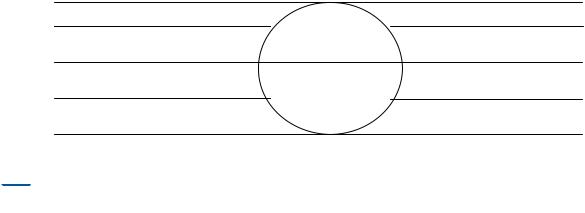
ENGLISH for Study and Work том 1
.pdf
4. Share the results of your work with your groupmates and the teacher.
Reading and Note-taking
5.Read the title and sub-headings of the text given below. Discuss with your partner the following questions:
• What is this article about?
• What do you expect to read about in the article?
• What do you expect to read in each part of the article?
• Why are some words printed in bold?
6.Read the text from English Learner’s Digest ‘Mineral Resources of Ukraine’ and mark the names of minerals in any suitable way (mark, circle or underline).
MINERAL RESOURCES OF UKRAINE
Ukraine is very rich in mineral resources. It contains iron and manganese ores, natural gas, salt, sulphur, graphite, flux, limestone. Ukraine also has deposits of oil, bauxite, ilmenite as well as black coal.
Mineral resources can be classified into three main groups: fuels, metals and nonmetals.
Fuels
Fuels include deposits of black and brown coal, oil, natural gas and peat. The reserves of black coal are concentrated in two basins: the Donetsk and Lviv Volynian Basins. Black coal is used for coke production. Coke is necessary for metallurgical industry and used while producing iron and steel. Deposits of brown coal or lignite are to be found in many places on the Right Bank of the river Dnieper. They form the large Dnieper Brown Coal Basin. The western oblasts of Ukraine contain small
9089
deposits of brown coal. Brown coal is used as local fuel for power stations, factories and plants also in household.
Three oil and natural gas regions have been discovered in Ukraine: the Subcarpathian, Dnieper-Donets and Black Sea regions. The most promising deposit of oil in Western Ukraine is the Dolyna field. In the Dnieper-Donets Region the largest gas fields are in Kharkiv Oblast. Gas deposits have been discovered in Sumy, Poltava and Dnipropetrovsk Oblasts. The Black Sea Region encompasses the southern part of Zaporizhzhia and Kherson Oblasts as well as northern part of Crimea.
Peat has been used in Ukraine for a long time. Its extraction has been greatly increased. It is important local fuel in industry. It is also widely used as bedding for livestock and as an organic fertilizer. The greatest deposits of peat are in Polissia, but it is also to be found in marshy river valleys.
Metals
Metals can be classified in two sub-groups: ferrous and non-ferrous metals. Iron ore is used in manufacture of iron and steel considered to be ferrous metals. The deposits of iron ore are one of the largest in the world. They are concentrated in Kryvyy Rih, Kerch, Kremenchuk and Bilozerka.
Ukraine is also rich in deposits of other ores: manganese, mercury, titanium and others. Ukraine is considered to be one of the richest places in the world for reserves in manganese ore which is used in the manufacture of high quality steel. Several deposits are located in Dnipropetrovsk and Zaporizhzhia Oblasts.
Titanium is important in the space, chemical, atomic and other areas. It has been discovered in Dnipropetrovsk Oblast. Mercury is obtained from cinnabar, the largest deposits being the Mykytyvsky field in the Donetsk Oblast. Ukraine has inexhaustible reserves of raw material for production of metallic magnesium, which is obtained from rich brine of Syvash Bay. Ukraine also has deposits of bauxites, used for producing of alluminium, nickel, cadmium, arsenic and antimony.
91890
Non-metallic Minerals
Ukraine’s depths are in non-metallic minerals, which are widely used in the national economy. The important ones among them are rock and potassium salts, sulphur, fire clay and building materials. The largest deposits of rock salt are centered in Donbas (Artiomovsk) and in Solotvyno (Subcarpathian Region) and in Transcarpathia. Subcarpathia has also deposits of potassium salts (Kalush) and the largest deposit of native sulphur (Rozdolske). The main deposit of fire clay is in the Donbas (Chasovoyarsk). Large reserves of red and grey granite, chalk, marl are also found in Ukraine.
There are also many curative mineral waters in Ukraine.
6. a Using the information from the text complete the table below with appropriate minerals.
WORKSHEET 2.1
FUELS |
METALS |
NON-METALS |
|
|
|
|
|
|
b Compare the results with your partner.
9210
7. Using the information from the text complete the table below with the information on mineral resources in every mentioned region/oblast of Ukraine. If necessary add the names of Oblast/Regions.
WORKSHEET 2.2
Region/Oblast |
Mineral Resources |
|
|
Dnipropetrivsk |
|
Region/Oblast |
|
|
|
Zaporizhzhia Region / |
|
Oblast |
|
|
|
Donetsk Region/Oblast |
|
|
|
Kharkiv Oblast |
|
|
|
Western Ukraine |
|
|
|
Subcarpathia |
|
|
|
Transcarpathia |
|
|
|
The Black Sea Region |
|
|
|
Crimea |
|
|
|
Kherson Oblast |
|
|
|
Poltava Oblast |
|
|
|
Sumy Oblast |
|
|
|
9321
Vocabulary
8. Match the names of minerals (1 – 25) in the left-hand column with their translation (a – y) on the right. Start with those which you can guess easily (they are associated with Ukrainian names). Use a dictionary when necessary.
1. |
potassium salt |
a. |
сірка |
2. |
marl |
b. |
торф |
3. |
iron ore |
c. |
природний газ |
4. |
mercury |
d. |
миш’як |
5. |
bauxite |
e. |
чорне вугілля |
6. |
titanium |
f. |
морська вода |
7. |
nickel |
g. |
ільменіт |
8. |
lignite |
h. |
вапняк |
9. |
oil |
i. |
цілюща вода |
10. |
natural gas |
j. |
сурьма |
11. |
black coal |
k. |
ртуть |
12. |
graphite |
l. |
кам’яна сіль |
13. |
peat |
m. |
боксит |
14. |
rock salt |
n. |
нафта |
15. |
ilmеnite |
o. |
титан |
16. |
cinnabar |
p. |
магній |
17. |
arsenic |
q. |
нікель |
18. |
bismuth |
r. |
буре вугілля |
19. |
antimony |
s. |
калійна сіль |
20. |
fire clay |
t. |
вісмут |
21. |
limestone |
u. |
вапниста глина |
22. |
curative water |
v. |
залізна руда |
23. |
brine |
w. |
графіт |
24. |
sulphur |
x. |
вогнетривка глина |
25. |
magnesium |
y. |
сурьма |
9432

9.Check the list of minerals above with those marked by you while reading (see 6). If necessary add minerals and their translation into the list.
10.Find in the text English equivalents to the Ukrainian word ‘родовище’.
11.Find in the text the verbs used with mineral(s), their names or deposit(s). Put them on the lines.
Eg. Ukraine has deposits of …( oil, bauxite, ilmenite as well as black coal).
Mineral(s)
deposit(s)
 Grammar Reference:
Grammar Reference:
Passive Constructions.
Follow-up
12.Sketch the map of Ukraine. Complete it with the symbols of minerals. Mark as many minerals as possible. If necessary use the text.
13.Be ready to describe the completed map to the group.
9543
Unit 2 Types of Mineral Resources
Focus on
•developing a range of vocabulary relevant to mining and geology
•synthesizing ideas
•orienting yourself to the text
•reading paragraphs to understand
•identifying main and supporting ideas
•finding key ideas of every paragraph
•skimming the text
•scanning the text
By the end of the unit you will:
•be able to orient yourself to the text using various strategies
•be able to distinguish between main and secondary points
•be able to understand text organisation
•be able to classify and sort the information
•have practiced reading for detail to obtain information (facts, data etc)
•develop your range of vocabulary in mining (mineral resources)
Warm-up
1.Write minerals you know on 16 separate little cards (a mineral on each card).
2.Group-work. Being in groups of three, in turn name the minerals one by one. In case your groupmates have the same mineral on their cards, leave only one card with a name of the mineral. Using your group stockpile of cards, make a list of minerals you know all together. Compare your list with the other groups.
9654

3. Using the stockpile of cards classify the minerals. Be ready to present your group classification and the principles it is based on to the whole group.
Reading
4. Group-work. Form 6 groups of two or three students. Each of the group (1 – 6) will read different paragraphs (A, B, C, D, E, F) from one text. Being in groups choose any of the paragraphs given below and start your group-work with a Prediction Chart.
Prediction Chart
Look at the paragraph you have chosen. Predict :
•What is it about?
•What do you expect to read about in the paragraph?
•What do you expect to read in the other paragraphs?
Share your predictions within your group, explaining what helped you to make the predictions. Put the predictions of all the groups on a poster.
5. Read the chosen paragraph from the list below and check whether your predictions were right.
A. Unsustainable resources make up most of the subsurface materials that geologists are called on to assess. A widely used method for assessing their availability is the McKelvey scheme. In this, the resource base of a commodity is the total amount that exists on Earth. For most commodities this amount is of no practical interest, because much of it could never be economically exploited. The resources represent the part of the resource base that might conceivably be economic in the future. Within this amount, only the reserves are both economic now and identified with some geological certainty. A final fraction, previously part of the reserves, has been already produced and used by society.
9765

B.Coal, oil and gas, minerals and rocks: these are typical geological resources. They are usually considered to be non-renewable, with society progressively depleting a fixed stock of each commodity. By contrast, water or air is usually termed renewable, because natural processes replenish and recondition the stock as it is used.
C.The criteria of the McKelvey scheme mean that estimates of reserves and resources vary with changes in economic conditions and geological knowledge (Fig. 5.2a). For instance, reserves appear to increase if the price of a commodity rises, making it attractive, to exploit lower-grade and less accessible resources. Conversely, increased costs of extraction and processing will lower the assessed reserves. Estimates of resources are dependent on geological assumptions about their formation and occurrence. Refinement of these geological models can either increase or decrease resource estimates.
D.However, renewability is not a simple measure. All resources are renewable on some timescale. For instance, oil and gas are forming now in the world's sedimentary basins, and mineral deposits beneath active volcanoes. On the other hand, water from rainfall may not be adequate to refill reservoirs or rock aquifers. A more helpful measure is the sustainability of a resource; whether or not its rate of use exceeds its rate of renewal. Most geological resources are unsustainable, because their formation processes are very slow on a human timescale. Oil is being used at least a million times faster than it is being recreated. Water and land are potentially sustainable resources, but only if managed correctly.
E. Sustainable resources are part of a cycle where the rate of use does not exceed the rate of natural replenishment. However, this balance involves quality as well as quantity. A geological resource such as groundwater is used and returned to nature in a dirtier, more degraded state than it was extracted. Natural reconditioning systems such as rivers, plants, evaporation and rainfall must be able to clean water fast enough. These systems are easily damaged by pollution, or even by the over-use of water itself. So excessive pumping can lower underground water levels, dry up natural springs, and starve the rivers which would have helped to purify the pumped water after use.
9876

F. Estimates are further complicated because changes in the reserves can themselves affect economic and social activity, forming feedback loops that slow the potential changes. So, apparent shortages in reserves raise the price of a commodity and therefore the pace of geological exploration, both factors that tend to increase the reserves again. Low estimates of reserves also stimulate recycling of some commodities such as metals, slowing the rate of depletion of the natural stock. Finally, the use of some geological resources maу be restrained not by the shortage of reserves but the shortage of safe places to dump the effluents from their production and use. The carbon dioxide derived from burning fossil fuels is the most serious example of this constraint.
6.Being in the same groups (1 – 6), decide on the main idea of the paragraph you have read.
7.Arrange 2 or 3 groups of six with the representatives from each of the groups (1 – 6) who read paragraph A, B, C, D, E, F. Being in groups of six, share the main ideas of the paragraphs you have read.
8.Being in the same groups of six, arrange the text in the correct order and give the title to it.
9.Come back to your original groups (1 – 6) and compare the order of the text and its title done by each of you while being in groups of six. Come to the common decision. Compare the results of your work with the other groups.
10.Check the results of your work with the authentic text given in Part II
Self-study Resources. Make any changes if necessary.
Follow-up
11. Using the text ‘Types of Geological Resources’ from Chapter RESOURCES of the textbook Geology and Environment in Britain and Ireland by Woodcock, N. (1994), make a diagram of the classification of minerals proposed by the author. Re-read the whole text if necessary.
9987
